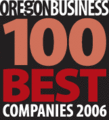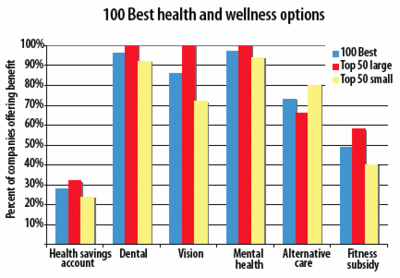 Out of all the benefits besides cash with which companies can attract and keep employees, none is more appreciated than health coverage. But at a time when health care costs are rising faster than inflation, offering a high-quality plan is easier said than done.
Out of all the benefits besides cash with which companies can attract and keep employees, none is more appreciated than health coverage. But at a time when health care costs are rising faster than inflation, offering a high-quality plan is easier said than done.
 Out of all the benefits besides cash with which companies can attract and keep employees, none is more appreciated than health coverage. But at a time when health care costs are rising faster than inflation, offering a high-quality plan is easier said than done.
Out of all the benefits besides cash with which companies can attract and keep employees, none is more appreciated than health coverage. But at a time when health care costs are rising faster than inflation, offering a high-quality plan is easier said than done.
To find out how this year’s 100 Best companies meet this challenge, we identified 10 that were rated particularly high by their employees for health benefits, and polled company representatives on what they were doing right.
Many noted that they are not really controlling costs; they are paying more than in years past. Yet they remain committed to their employees’ health and well-being, convinced that it translates directly into the success of their business. “There have been tough choices,” says Doreen Barnhouse, operations VP at The Partners Group (Small Company No. 20, Portland), “but they have come in the form of understanding the value of our employees and having the company shoulder the majority of the pain. Keeping a quality employee over a longer period of time is less expensive than paying more in health insurance.”
How to get more for less
• Involve employees:
Most of the companies stressed the value of employee participation when choosing health plan carriers, options and other de-tails. Not only does this help tailor the plan to employees’ health care preferences, it makes them more aware of the costs and limits among the available choices. Employees can help decide whether the rising cost of premium health care — potentially impacting profit sharing and overall success of the business — is worth it. When Becker Capital Management (Small Company No. 35, Portland) was shopping for a provider, CEO Janeen McAninch says, “We looked at the geographical locations of hospitals and clinics and asked our employees where they would likely go for major medical care.”
• Consider using the same broker/carrier for all policies: If the broker gives a discount for it, bundle your health care, life, property and casualty, and workers’ compensation policies.
• Create an employer-sponsored self-insured health plan: If your company has a large number of employees and is willing to expose itself to the risks, normally assumed by an insurance company, of paying claims directly, it can avoid paying the profit margin built into insurance premiums. “This is how we can monitor our claims and keep our plan lean,” says Tana Mallory, HR manager for WRG Design (Large Company No. 19, Portland). “We make the decisions with our plan structure and coverage options, so we are able to reap the rewards on good years where claims were low.” Self-insured companies usually contract with a third-party administrator to administer health benefits to employees. Another self-insured company, Walsh Construction (Large Company No. 7, Portland) saw savings after contracting with Clackamas-based Innovative Care Management, which specializes in case management for employees with complex or chronic medical conditions. “Over the last three quarters that we have utilized their services,” says HR manager Cristen Kolberg, “our return on investment has been $4.99 to every $1 spent.”
• Join a professional employer organization (PEO): If you find that your insurance broker/carrier charges a higher premium for your relatively small workforce, you can get into a larger risk pool through a PEO and often obtain better rates. Bev Davis, COO of Jordan Schrader (Small Company No. 15, Lake Oswego) has outsourced some of the law firm’s HR and most of its benefits administration to a PEO, Xenium Resources, resulting in good benefits at a lower price than she says she could find on the open market.
• Set out-of-pocket maximums: This can be used to give employees, especially those with families, an added a sense of security even though they have to foot some of the bill. At Walsh Construction the maximum an employee can pay in a year is $1,000, with a $200 deductible. VTM (Small Company No. 21, Portland) doesn’t have a maximum but offers a similar, novel solution. Vice president Bruce Murray says that last year co-pays and deductibles went up, but he adds, “We made one giant leap because we promised our employees ‘financial stability.’” In response to the greater out-of-pocket expenses, the company will now reimburse employees when they feel their financial stability is threatened by medical expenses.
• Shop carriers and plans each year: “I consider quotes from at least three health insurance providers each year,” says Vie Radek, controller at Palo Alto Software (Small Company No. 25, Eugene), “and try to pick the one that gives us the best benefits for the money.”
• Institute a wellness plan: Insurance companies may give you a discount for it. Verné Boerner, administrative officer for Northwest Portland Area Indian Health Board (Small Company No. 40, Portland), credits a tobacco cessation policy and company-sponsored membership at 24-Hour Fitness with helping to negotiate lower insurance rates. PREM Group’s (Small Company No. 12, Portland) Rhonda Zender says her company is arranging for a dietitian to speak to employees, as well as for yoga and kickboxing classes.
• Health savings accounts (HSAs): Surprisingly, only two out the 10 companies who we polled mentioned an HSA, which is intended to limit employees’ health care spending by granting them a set amount of funds with which to budget their total care. PREM Group’s Zender reported having some success with an HSA, but Radek of Palo Alto Software says, “I am very frustrated by the way insurance providers have set up HSA accounts — they make them very unattractive and have really defeated the whole concept.”
• Raise co-pays and deductibles: Our 100 Best companies say increasing employee out-of-pocket costs is preferable to making them pay more of the premium or eliminating coverage. Walsh Construction raised co-pays on name brand drugs but lowered them on generic alternatives, producing a noticeable savings to their self-insured plan.
— Brandon Sawyer
100 BEST RESULTS
Not surprisingly, in our 100 Best employee survey this year health plan-related issues were ranked high in importance: fifth, sixth and eighth out of 50. However, they dropped about 10 ranks in satisfaction, indicating that most of the 29,000 Oregon employees who participated are not wholly satisfied with their employer’s health care coverage.
| Rank out of 50 | ||
| 100 Best employee survey health care statements | Importance | Satisfaction |
| Quality of health plan for employees and families | 5 | 14 |
| Cost of health insurance for employees and families | 6 | 23 |
| Health insurance plan options (dental, alt. care, vision, etc.) | 8 | 15 |

Have an opinion? E-mail [email protected]

